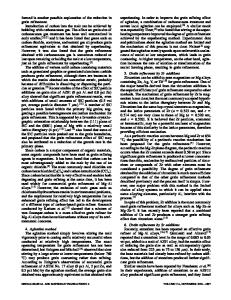Grain refinement of magnesium alloys
- PDF / 2,193,089 Bytes
- 11 Pages / 612 x 792 pts (letter) Page_size
- 6 Downloads / 337 Views
I. INTRODUCTION
ACHIEVEMENT of a fine grain size generally leads to improved mechanical properties and structural uniformity of most metals and alloys. Thus, a fine grain size in castings is important for the service performance of cast products and is also important for the final properties of semifabricated products, e.g., extrusions that are produced from cast billet. High-pressure die castings (HPDCs) normally have a fine microstructure because of the extremely high solidification rates that are achieved and do not need the addition of a grain-refining agent. However, the solidification rate in sand castings, permanent mold castings, and direct chill billet castings is much slower and a uniform fine microstructure can generally only be achieved in these castings by use of a grain-refining additive prior to casting. Depending upon whether they are alloyed with aluminum, magnesium alloys can be generally classified into two broad groups: aluminum free and aluminum bearing. Aluminumfree alloys mainly refer to those containing zirconium or grain refined by zirconium such as ZE41, ZK60, WE43, AM-SC1, and ML10. These are an important high value added class of alloys that are based on the exceptional grain-refining ability of zirconium when added to alloys that do not contain aluminum. Aluminum bearing alloys such as AM50, AM60, DAVID H. StJOHN, CEO, CRC for Cast Metals Manufacturing (CAST), is with the University of Queensland, Brisbane, QLD 4072, Australia. Contact e-mail: [email protected] MA QIAN, Lecturer, is with the Brunel Centre for Advanced Solidification Technology, School of Engineering and Design, Brunel University, West London UB8 3PH, United Kingdom. MARK A. EASTON, Research Fellow, is with the School of Physics and Materials Engineering, Monash University, Clayton, VIC 3800, Australia. PENG CAO and ZOË HILDEBRAND, Postgraduate Students, are with Materials Engineering, School of Engineering, The University of Queensland, Brisbane. This article is based on a presentation made in the symposium entitled “Phase Transformations and Deformation in Magnesium Alloys,” which occurred during the Spring TMS meeting, March 14–17, 2004, in Charlotte, NC, under the auspices of ASM-MSCTS Phase Transformations Committee. METALLURGICAL AND MATERIALS TRANSACTIONS A
and AZ91 comprise the basis of the current magnesium business and have been predominantly used in HPDC applications. The exceptional grain-refining ability of zirconium does not occur in these alloys, as aluminum and zirconium can readily form stable intermetallic phases, which are unfortunately ineffective as nucleants for magnesium grains. Currently, a suitable grain refiner, i.e., reliable and easy to apply, does not exist for this group of alloys. It has long been anticipated that such a grain refiner would allow alloys such as AZ91 and AZ31 to be used more extensively in non-HPDC applications, particularly for AZ31, as the demand for high-quality extrusion billet increases. This is because grain refinement can effectively reduce hot tearing suscept
Data Loading...











